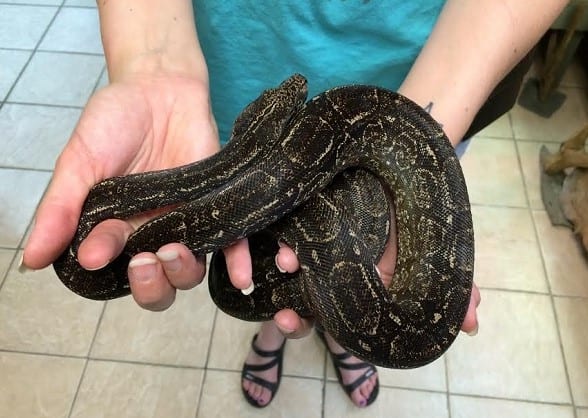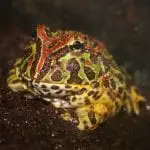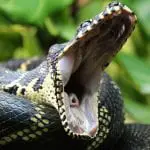Scientific Facts
| Common Name | Argentine Boa Constrictor |
| Scientific Name | Boa constrictor occidentalis |
| Life Span | 20 to 30 years |
| Size | 7 to 10 feet |
| Habitat | Scrub woodlands and grasslands |
| Country of Origin | Argentina and Uruguay |
Physical Description

The Argentine boa constrictor is one of the most common boa constrictor species. These snakes can be 7 to 10 feet long with black or dark brown coloration with remarkable patterns all over their bodies. These patterns can be in white or pale gold, which made them different from other boa constrictors.
Also, these snakes usually have a greyish abdomen and a dark lining that runs from their necks to the tips of their snout and from their eyes to their necks. The young snakes often have a pinkish body which will darken as they grow.
Geographic Location
The Argentine boa constrictors are native in Argentina and Uruguay. Some of them were also found living in Bolivia.
Habitat
These snakes love to be in humid forests, though they can also be seen in the scrub woodlands and grasslands. A few of them prefer to live in rocky slopes.
Behavior

The Argentine boa constrictors are nocturnal snakes. They are carnivores, so they can eat birds and small animals. These boas are extremely active creatures as they always climb on trees in the forests. Despite being very active, these snakes are quite docile though they may hiss and become aggressive when anxious or scared. Like other boa constrictors, the Argentine boas also love to soak themselves in the water.
Reproduction
The breeding time for Argentine boa constrictors occurs in June and July. Every female snake can lay 10 to 40 live hatchlings after the copulation that occurs in late fall until early spring.
Captivity and Life Span
Keeping Argentine boa constrictors means you need to provide them with branches inside their enclosure. These active snakes will surely enjoy climbing through these branches whenever they want to. These boas can be good pets even for first-time snake keepers.
Shedding
Your pet will not struggle to shed if the enclosure maintains the ideal humidity level. The snake should be able to get through this on its own. You’ll learn it’s about to shed when its eyes look cloudy, and the snake stopped eating. Everything will fall back into place soon after shedding.
Housing
Adult Argentine boas are less likely to climb due to their size. In keeping a baby snake, a 10-gallon tank will be enough. After a year, you may increase the enclosure’s size. You can buy glass aquariums and the commercially available reptile cages made of plastic. Young Argentine boa constrictors are okay with enclosures measuring 30 inches x 12 inches or 36 inches x 18 inches.
If you are using a glass tank, then there should be a moist hide – something with damp moss inside for added humidity. Baby snakes can be shy and will feel better and safer if they have a hide inside the cage. Putting two hides – one on the cool section of the enclosure and the other on the warm section is a good idea.
Adult Argentine boa constrictors will be happy to be a custom-made enclosure or a big 6-ft. molded plastic cage. The one measuring 6 feet x 3 feet might be okay but go for a larger enclosure.
Heat and Lighting
Argentine boa constrictors originated from warm climates. Like other reptiles out these, these snakes depend on exterior thermoregulation in controlling and maintaining the ideal body temperature. Thus, the enclosure of your pet must have both the cool and warm sides. For instance, the heat elements are on the left side, while the right side stays cool and comfortable. With this setup, your pet can easily move and switch positions to keep itself feeling comfortable.
The warm side of the enclosure can be a basking spot for your snake. The temperature on this side must be between 88 to 90 degrees Fahrenheit. For the cool side, the temperature should be between 80 to 85 degrees Fahrenheit. Drops in nighttime temperature are no longer necessary.
You can put the heat pads on the warm side of the cage with the hide box on top. Also, the basking light must be of the best quality. Don’t forget to add an efficient temperature gauge and a rheostat or timers for controlling the heat inside the enclosure.
Humidity
Also, don’t forget that your pet needs a constant supply of fresh and clean water. Buy a non-porous bowl and fill it with water every day. Keep the water bowl clean, as well. Scrub it at least once every week to wash away bacteria and prevent them from accumulating. By maintaining the humidity level at 60% to 70%, your pet can shed properly. A hand mister is enough, but you can also use the automatic mister.
Feeding
Don’t handle your pet for a long time before feeding it. This boa constrictor is an ambush eater that is so aggressive when being fed. Thus, you must always feed it inside the enclosure. This docile snake shows an impressive feeding response. However, babies can be slightly defensive.
You can feed the babies and juveniles with one medium-sized rate once every week. Make sure the food is of the same size as the widest part of your pet’s body. Boas of all forms have a sluggish metabolism, so always feed them right. When fed, avoid touching your pet in the next 24 hours. For adults, you may cut back to just one rat every two weeks if you like. Keep on feeding your pet once a week with a bit smaller food.
Note: Don’t feed your pet when it sheds. Just wait until it’s done with shedding. If you’re worried that the snake is thinking that you’re going to feed it whenever you touch it, then use a snake hook instead. Hook your pet out of the cage whenever you like to hold it. You can buy a collapsible hook for a baby snake or a larger hook for older and adult snakes.
Availability – Where to Get One?
Argentine boa constrictors are easy to find locally and even online. You can visit the local and online pet stores and professional breeders to buy healthy hatchlings or young snakes.
How to Care for an Argentine Boa Constrictor?
Since the Argentine boa constrictors are easy to keep, taking care of them should not be a challenging task even for a newbie. Just provide the snake with a safe and comfortable enclosure, ample food, a good substrate, a nice water dish, and other caging accessories like branches and hide boxes. With all these things, your Argentine boa constrictor will stay active, happy, and healthy.
FAQs
Do Argentine boa constrictors bite?
Argentine boa constrictors don’t bite. Instead, they coil up and wrap their bodies on their prey to kill it.
Are Argentine boa constrictors poisonous?
Argentine boa constrictors are non-venomous, just like other boas. They are docile and rarely show aggressiveness.
How long do Argentine boa constrictors live?
Argentine boa constrictors have a longer lifespan. In captivity, they can live for 20 to 30 years or even longer.
Are baby Argentine boa constrictors friendly?
Hatchlings or young Argentine boa constrictors can be a bit defensive. They become friendly and calm with quick but regular handling.


